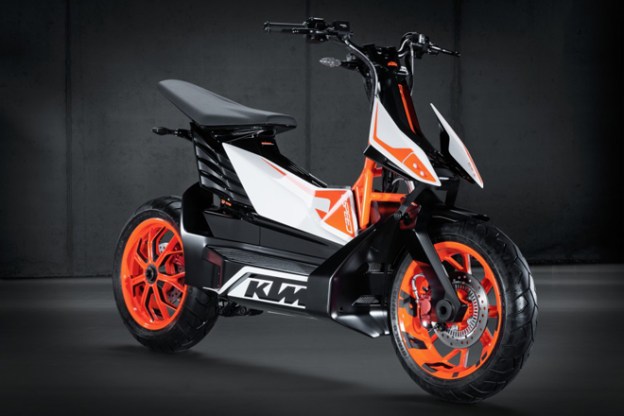 Unless you’ve been hiding under a rock, you know that scooters are now one of the hottest crazes when it comes to urban mobility.
Unless you’ve been hiding under a rock, you know that scooters are now one of the hottest crazes when it comes to urban mobility.
With the debut of new KTM E-Speed concept, the excitement for the popular city two-wheelers – especially those driven by electricity alone – is likely to grow even more.
The E-Speed, which debuted at the Tokyo Motorcycle Show, is powered by a liquid-cooled, permanent-magnet synchronous motor with 36Nm (26 lb-ft.) of maximum torque and a permanent power of 11kW (14 hp) to drive the rear wheel via a belt drive.
Based on technology used in KTM’s FREERIDE E off-road motorcycle, the E-Speed’s electricity is stored in a package of cutting-edge lithium-ion batteries with a capacity of 4.36kWh that can fully recharge within two hours on a regular 220V socket. The range is around 37 miles on a single charge.

Known for their colorful and unconventional bodywork on their gas-powered motorcycles, KTM was intent on making sure every component of the sport-oriented E-Speed lived up to the aesthetic and structural function of the brand, from the scooter’s chassis to the overall sci-fi look of the bike.
“In the long term, the electric drive will come out on top for short distances – particularly in areas which are highly sensitive from an environmental perspective, like open nature and densely populated metropolitan areas,” said Stefan Pierer, KTM CEO. “Vehicles like the ‘E-SPEED’ and FREERIDE E can help powered two-wheelers win back more acceptance in society. Not just because of their environmental credits, but because they are easy to use, quick, and simply great fun.”
The “E-SPEED” prototype has a top speed of 85km/h (52 mph). Other design features include a hybrid steel trellis light metal frame and WP suspension components.
What do you think of the KTM E-Speed? Would you ride it? Why or why not?


